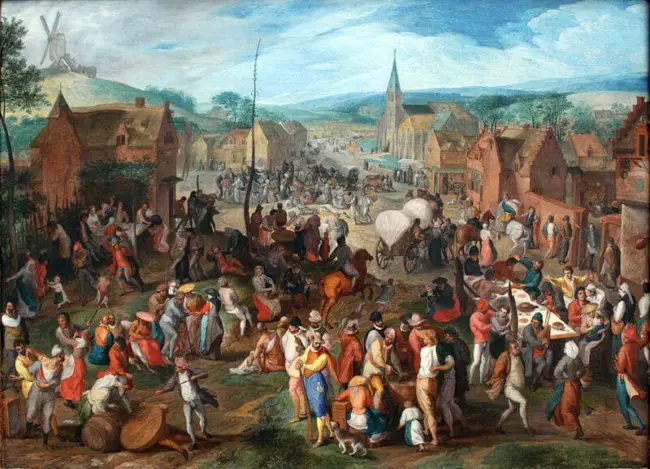Mercantilism: Definition, Characteristics & Examples

What is Mercantilism?
Mercantilism is an economic policy from 1500-1800 that aims to maximize exports and minimize imports through subsidies and tariffs. Originally adopted in Europe, its aim was to boost exports and reduce international imports by making it more expensive.
It originates from the term ‘mercantile’, referring to merchants and trade, and is based on the belief that trade with other nations should be regulated through protectionism.
Key Points
- The balance of trade was a key component of mercantilism – imports were bad, and exports were good.
- Mercantilism focused on controlling gold in order for colonists to pay for its large armies and expand its empire.
- At the core of mercantilist belief was that one nation could only benefit at another nations expense.
Trade imbalances became a concern as countries traded more. If a nation imports more than it exports, it faces a net outflow of gold. For example, if country A exports $60 to country B but imports $100, it has a trade deficit of $40, resulting in an outflow of $40.
At the time, nations aimed to produce enough for themselves and earn a net income from abroad, as they lacked floating exchange rates. There was fear that other nations might accumulate enough gold to launch an invasion.
History of Mercantilism
Mercantilism was a popular economic school of thought in Europe between the 16th and 18th centuries, but it was not officially named until Adam Smith’s book ‘A Wealth of Nations‘ in 1776. By adopting such a strategy, European powers aimed to limit imports and encourage exports to stimulate domestic employment and bring gold and silver into the country.
This period saw religious and commercial warfare, as well as the Age of Discovery, with the British, French, and Spanish empires expanding rapidly. Gold became increasingly important, as it funded the empires’ military and represented wealth and power.

Image: By Gillis Mostaert/Public domain
As colonies grew, trade between imperialist nations became more interconnected. The British empire had links to Australia, India, Canada, and parts of Africa, while France had colonies in Africa, North America, and Asia. The colonies provided raw materials to the mother country, such as sugar, tobacco, fruits, and gold, which would be converted into final goods and sold at a higher price, enhancing the mother country’s wealth.
By controlling the supply of goods and gold between trading destinations, the mother country was able to ensure a favorable balance of trade and control the full supply chain between nations, preventing other colonies from acquiring the same goods.
Characteristics of Mercantilism
1. Accumulation of Gold
Gold represented wealth and power, allowing nations to fund military expansion and symbolize their prosperity. It was also seen as protection against invasion, and a lack of gold was viewed as a potential threat to the nation’s survival.
As gold mines were scarce in colonist nations like Great Britain, France, and Spain, they relied on their colonies for its supply. By procuring raw materials from the colonies, they could convert them into final goods and sell them for a profit in gold.
2. Belief that Wealth is Static
Mercantilism was based on the belief that wealth was fixed, and gold was a scarce resource, creating a limited supply. If a nation imported more than it exported, it was viewed as losing wealth, with one nation benefiting at another’s expense. Therefore if a nation had a trade deficit, it saw this as a drain of its resources to foreign powers.
3. Large Population
Mercantilist theory held that a large population was crucial to provide labor, markets, and an army for the nation, resulting in greater wealth accumulation and a larger army. As a result, larger populations were seen as associated with increased national prosperity.
4. Positive Balance of Trade
Mercantilists believed that by exporting more than they imported, a nation could accumulate wealth from other nations. On the other hand, if a nation imported more than it exported, it was essentially sending its gold, wealth, and power abroad.
5. Reliance on Colonies
Colonists relied on their colonies not only for raw materials but also for a net transfer of wealth and gold to finance further global expansion. This also helped the mother nation become self-reliant in the long term.
6. State Monopolies
The state held a monopoly in supplying its colonies since it was the only nation able to import or export to them. The mother countries relied on their colonies for raw materials, which were then converted into final goods and sold back at a profit, resulting in a net transfer of gold from the colonies to the colonists.
7. Trade Barriers
Several empires prohibited trade between their colonies and those of other empires. For example, when Britain controlled India, it was not allowed to trade with other colonies such as Australia or Canada. Additionally, many nations implemented tariffs to increase the cost of imports and make them less competitive.
The goal was to limit imports without completely eliminating necessary goods. Nonetheless, nations were able to obtain key resources from their colonies to ensure self-sufficiency.
Mercantilism Examples
Mercantilism, a protectionist economic policy, was prevalent during the Age of Discovery (16th – 18th Centuries) and gained popularity among seafaring European nations such as Spain, Britain, France, and Portugal as they explored other parts of the world. Some examples include:
British Navigation Act 1651
In 1651, the British government, under Oliver Cromwell’s leadership, enacted a law that prohibited any foreign ship from transporting goods to or from its colonies. All trade was required to be conducted by a British ship with a British owner, master, and mostly British crew.
Colbertism
Colbertism is named after Jean-Baptiste Colbert, who served as First Minister of State in France from 1661 to 1683. It refers to the mercantilist policies implemented during his tenure, which included tariffs, public works programs, and the establishment of the French merchant navy to expand exports.
East India Company
The British government established the East India Company in 1600 as a state-sponsored monopoly to capitalize on the Asian markets, especially the East Indian spice trade. Although privately owned, it was granted monopoly power in the market until 1813, when the British government revoked it.
From its inception to its decline, the East India Company paid the British government for exclusive trading rights with India. This not only brought gold back to Britain but also helped establish a strong and lasting trade route between Britain and its colonies.
Arbitristas of Spain
The arbitristas were a group of reformists in Spain who were worried about their country’s decline. They were primarily concerned about Spain’s growing dependence on its colonies to provide necessary resources, which was hurting domestic business and the Spanish people. The arbitristas suggested stricter regulations on imports and tax subsidies for agricultural workers to boost domestic business and exploit the nation’s colonies through exports.
Criticisms of Mercantilism
At the core of mercantilism lies the idea that wealth is centered on the accumulation of gold and other precious metals. However, today, a nation’s wealth is considered to derive from its GDP or economic output. This is because true wealth is based on what the land and labor produce, not on how much gold a nation possesses. Gold cannot cure hunger unless exchanged for food. Therefore, mercantilists’ preference for self-sufficiency and refusal to import ignores the fact that some nations cannot grow enough to feed themselves, as in Spain. Although Spain had a high level of gold, the majority of its population went hungry.
A nation that cannot provide basic necessities for itself cannot be considered wealthy. Moreover, the monopolies that the state granted prevented domestic firms from competition. By placing high tariffs and restrictions on imports, domestic firms were largely insulated from competitive pressures, which would have created an incentive for firms to improve the efficiency of production to produce at a lower price.
The attack on imports was based on the principle that wealth is static and cannot increase, meaning that one nation’s loss is another’s gain. Yet this assumption is false. Adam Smith highlighted the reason in his book “The Wealth of Nations.” Smith identified “comparative advantage,” whereby one nation is comparatively more efficient at making Product A, while another country is better at making Product B. By focusing on the product that a nation is most efficient at making, both nations will obtain a higher output and, therefore, more wealth.
Related Topics
FAQs
Mercantilism is the belief that importing goods is bad as it transfers gold and wealth abroad. In turn, mercantilists use trade barriers such as tariffs, quotas, and regulations to prevent imports and ensure a positive trade balance.
Mercantilism reduces trade and cooperation between countries, which makes goods more expensive and difficult to procure. For example, tropical fruits cannot be grown in western countries such as the UK and France, so need to be imported. At the same time, it forces a country to be self-reliant. That isn’t always the most economically efficient, as other countries may be able to provide goods at a lower price than can be achieved domestically.
The 7 characteristics of mercantilism are:
1. Desire to accumulate gold
2. Belief that Wealth is Static
3. Desire for Large Population
4. Positive Balance of Trade
5. Reliance on Colonies
6. State Monopolies
7. Trade Barriers
Mercantilism had a significant impact on the economies of Europe and the New World during the 16th to 18th centuries. It helped to spur economic growth and development, but it also led to increased competition between nations, colonization and exploitation of other countries, and tensions that contributed to wars and conflicts.
Mercantilism differed from other economic systems, such as laissez-faire capitalism and socialism, in its focus on trade and the accumulation of wealth. While laissez-faire capitalism emphasized free markets and limited government intervention, and socialism emphasized social ownership and control of the means of production, mercantilism was characterized by strong government intervention and protectionist policies.
About Paul
Paul Boyce is an economics editor with over 10 years experience in the industry. Currently working as a consultant within the financial services sector, Paul is the CEO and chief editor of BoyceWire. He has written publications for FEE, the Mises Institute, and many others.

Further Reading
 Excise Tax: Definition, How it Works & Examples - An excise tax is a tax that is levied on specific products, usually in order to create a socially optimal…
Excise Tax: Definition, How it Works & Examples - An excise tax is a tax that is levied on specific products, usually in order to create a socially optimal…  The Importance of Property Rights - An efficient free market is reliant on strong property rights as a fish is to water. Its purpose is to…
The Importance of Property Rights - An efficient free market is reliant on strong property rights as a fish is to water. Its purpose is to…  Price Discrimination: Definition & Examples - Price Discrimination is a strategy businesses use to maximise revenue. Sellers charge customers different prices based on the maximum they…
Price Discrimination: Definition & Examples - Price Discrimination is a strategy businesses use to maximise revenue. Sellers charge customers different prices based on the maximum they… 